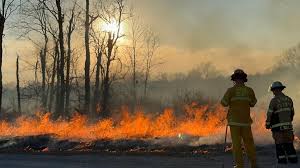Missouri Natural Cover Fire Risk
 Boone County Fire Protection District firefighters work to control a natural cover fire during continuing dry conditions in 2025.
Boone County Fire Protection District firefighters work to control a natural cover fire during continuing dry conditions in 2025.
The Missouri Division of Fire Safety, the National Weather Service and local fire response agencies in affected areas of Missouri discourage open burning when the weather service or local authorities advise against burning due to elevated fire risks because of dry conditions.
Whether contemplating the burning of brush or setting a campfire, always consider conditions and whether starting a fire is worth the very real risks to lives and property.
In March 2025, very dry vegetation, low relative humidity levels and breezy conditions led to a rash of wildland or natural cover fires across Missouri. On March 14, strong winds led to the spread of well over 100 wildland fires around the state, straining fire resources. Some fires damaged and destroyed structures. That day, the Boone County Fire Protection District responded to 21 of wildland fires; in Camden County, there were reported to be 30 wildland fires burning simultaneously.
Missouri's burn ban statute calls on counties in the state to contact the Office of the State Fire Marshal/Division of Fire Safety for consultation before imposing a burn ban.
When a county commission determines a burn ban is necessary, the county should contact the Office of the State Fire Marshal by email at firesafe@dfs.dps.mo.gov for confirmation that the ban is appropriate.
State Fire Marshal Tim Bean urges Missourians to refrain from burning leaves or brush in the areas of our state where the National Weather Service and local officials were warning of elevated fire risks. Any activities that could spark a fire should be avoided.
Natural cover fires not only pose a risk to lives and property, they place emergency responders in harm’s way and can delay their ability to respond to house fires, vehicle crashes, medical calls and other emergencies. Smoke from wildland fires can also reduce visibility leading to traffic crashes and create medical issues for people with respiratory conditions.
The Division of Fire Safety continues to discourage open burning whenever the weather service or local authorities advise against burning due to elevated fire risks.

 Click to enlarge and go to U.S. Drought Monitor Missouri page
Click to enlarge and go to U.S. Drought Monitor Missouri page